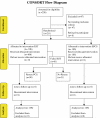Emergency portacaval shunt versus rescue portacaval shunt in a randomized controlled trial of emergency treatment of acutely bleeding esophageal varices in cirrhosis--part 3
- PMID: 20658205
- PMCID: PMC2956038
- DOI: 10.1007/s11605-010-1279-7
Emergency portacaval shunt versus rescue portacaval shunt in a randomized controlled trial of emergency treatment of acutely bleeding esophageal varices in cirrhosis--part 3
Abstract
Background: Emergency treatment of bleeding esophageal varices in cirrhosis is of singular importance because of the high mortality rate. Emergency portacaval shunt is rarely used today because of the belief, unsubstantiated by long-term randomized trials, that it causes frequent portal-systemic encephalopathy and liver failure. Consequently, portacaval shunt has been relegated solely to salvage therapy when endoscopic and pharmacologic therapies have failed.
Question: Is the regimen of endoscopic sclerotherapy with rescue portacaval shunt for failure to control bleeding varices superior to emergency portacaval shunt? A unique opportunity to answer this question was provided by a randomized controlled trial of endoscopic sclerotherapy versus emergency portacaval shunt conducted from 1988 to 2005.
Methods: Unselected consecutive cirrhotic patients with acute bleeding esophageal varices were randomized to endoscopic sclerotherapy (n = 106) or emergency portacaval shunt (n = 105). Diagnostic workup was completed and treatment was initiated within 8 h. Failure of endoscopic sclerotherapy was defined by strict criteria and treated by rescue portacaval shunt (n = 50) whenever possible. Ninety-six percent of patients had more than 10 years of follow-up or until death.
Results: Comparison of emergency portacaval shunt and endoscopic sclerotherapy followed by rescue portacaval shunt showed the following differences in measurements of outcomes: (1) survival after 5 years (72% versus 22%), 10 years (46% versus 16%), and 15 years (46% versus 0%); (2) median post-shunt survival (6.18 versus 1.99 years); (3) mean requirements of packed red blood cell units (17.85 versus 27.80); (4) incidence of recurrent portal-systemic encephalopathy (15% versus 43%); (5) 5-year change in Child's class showing improvement (59% versus 19%) or worsening (8% versus 44%); (6) mean quality of life points in which lower is better (13.89 versus 27.89); and (7) mean cost of care per year ($39,200 versus $216,700). These differences were highly significant in favor of emergency portacaval shunt (all p < 0.001).
Conclusions: Emergency portacaval shunt was strikingly superior to endoscopic sclerotherapy as well as to the combination of endoscopic sclerotherapy and rescue portacaval shunt in regard to all outcome measures, specifically bleeding control, survival, incidence of portal-systemic encephalopathy, improvement in liver function, quality of life, and cost of care. These results strongly support the use of emergency portacaval shunt as the first line of emergency treatment of bleeding esophageal varices in cirrhosis.
Trial registration: ClinicalTrials.gov NCT00690027.
Conflict of interest statement
There was no conflict of interest relevant to this article on the part of any of the authors and no financial interests, relationships, or affiliations.
Figures



